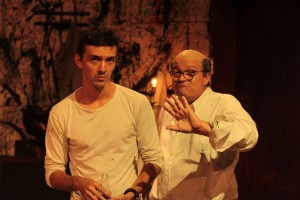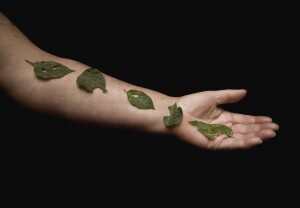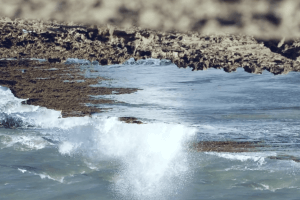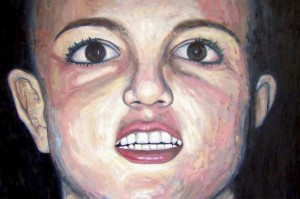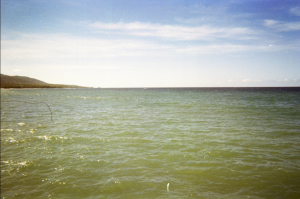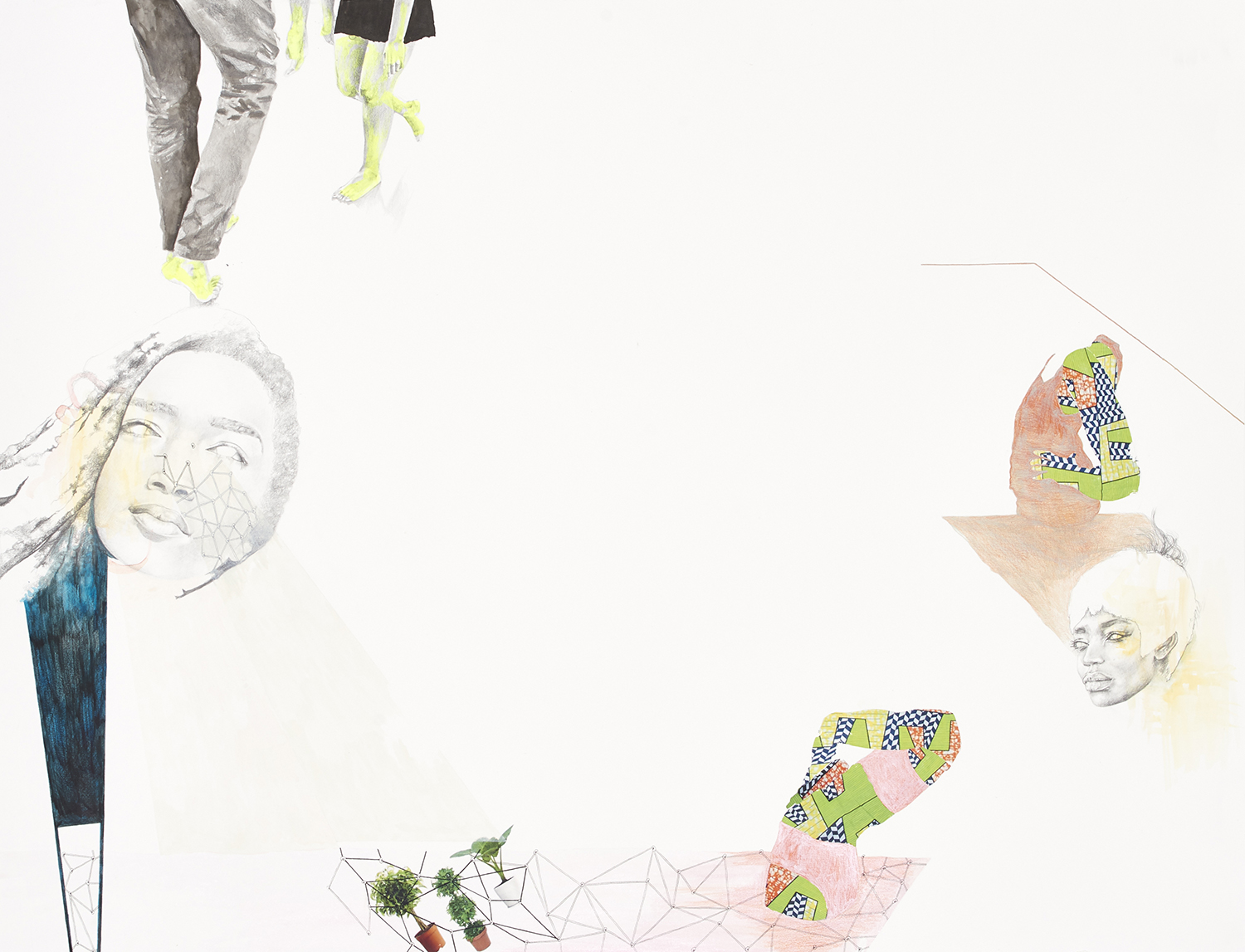
Chapter One: SPACE
There’s a simple and lovely magic in occupying middle space. Space that overlaps, space that folds into wonderful and complex origami structures. The space in your pocket or your mouth. The space in between the chair legs or spokes of a fork, so perfectly considered and accounted for. Space that expands infinitely and only appears to be contained by the presence of corners or windows. Flying feels easy and uneventful, and the laws of physics are mere suggestions. There’s no utopia here (in the drawings) –this isn’t about fantastical futuristic desires. It’s a present universe –one of many. I was born into this universe without the language to articulate or validate its existence. Thankfully, I met:
Chy (aka Zoë) Wura-Natasha TéTé Akwaeke Sameer Medha Ana Ofunne (formerly known as Mary Ann) and Gurjot (partially known as Josie)
And countless more in-betweeners…
I’m not afraid to fill in only as much as the drawing requires. First it was about activating a literal middle space, but then the middle became the everything. Saturation isn’t for me. In my hands, it would feel like a trick, a ploy, a thing to try to keep you busy. The honest me drank from the ‘less is more’ fountain, although I don’t think the seeming absence of activity is really less. I think on the contrary it has the potential to require so much more of us.
I think about the magnitude of the millimeter. I think about the difference one degree of the 360 will make. I think about the depth of paper- seemingly flat, but in actuality, miles and kilometers deep. I think about the corners of the sky. I think about delicacy and deliberation, but also intuition and spontaneity. Listening to the drawing…us being in conversation with each other. At times, these explorations come from erasing over and over and over and over and over. Other times, they seem to just land perfectly in place. Either way, this is a large part of the process. Arranging space. Inventing and suggesting through placement and design, not through some deep allegiance to storytelling.
Chapter Two: STORY-TELLING
If my grandmother told my mother a story, and my mother then told me that same story, the story has already become its own thing belonging to neither of its tellers. The inherent nature of a story is its built-in allowance to only be partially true. Every telling of it inevitably changes it- adds something, takes something away, embellishes, subordinates.
Nursery rhymes. Spirituals. Folktales. Parables. Haikus. Stories that old people tell under trees. Stories children tell that feel equally possible and full of colorful lies.
Maybe Beyoncé is a modern-day Greek mythology, that will be retold in the next century but with her having wings instead.
DJs curate the seamless intersection or overlapping of sounds. Thinking quickly they find a 1962 piece and lay it over yesterday’s song. In a related way, I collide imagery: a merman + the woman from Fela Kuti’s album cover + the memory of two dancers on stage in Brooklyn + that thing my mom said on the bus + the color of a wall in Tulum + a gesture from an Egon Schiele drawing + some gravity defying houseplants and a galaxy connected by birds.
There was that one drawing that started with Wura recounting a rooftop picnic in Lagos. The roof’s floor was lined with astroturf. This began my obsession with astroturf as something that could alter space…something real but unreal…something that bridged outside and inside, public and private. My studio is full of rolls of fake grass.
A piece of a real story became a piece of a fabricated world.
Or the one where I’d just returned from Nigeria and it felt as if Pidgin (a beautifully ‘inauthentic’ pieced together, hybrid English) was rapidly leaving my mouth, the less I got to use it. So Pidgin, a pigeon in a green glittered unitard, held ada’s mouth together so it wouldn’t escape as she ran.
Or the podcast I heard of the discovery that the sun had a celestial sister, which led to the appearance of two suns in the drawing plane. And what would it be like if a window opened into a pink swimming pool, full of gold black eyed peas?
The stories are non-linear and mostly made-up. I think of its parts as puzzle pieces or bricks, and I’m not the author of the narrative, just the facilitator. I collect, sort and archive them. I pull them out of both secret hiding places and blatantly visible places. I erase, I alter, I overlap. I organize them spatially, so you can enter the drawing and fill in the end, or the beginning, or the middle.
I’ve been asked about the origin, but I think the origin at some point, stops being important. It doesn’t dissolve, but time does pass and even our skin becomes new. So how audre the Leopard came to be, is of less significance than where audre the Leopard is right now (on the page).
audre, the Leopard (male presenting they) ageless, but perhaps older than the others
Tritón (it) a bit of a bore, but for all those who come from the water
ada, the Alien (she) looks like me but isn’t
Twin (androgynous they) a double-bodied, headless entity, full of mischief, child-like
Pidgin (it- who I think may have died for the time being), formerly Twin’s accomplice in crime
Ofunne and the army of Ghosts (she plural) some strangers, mostly women I know
Unidentifed Colored Blobs (male) architectural structures
Zebra– waiting for renaming (they) the only one that is neither hybrid or alien, or ghost –just “animal”
Forms. Beings. Characters. aliens, hybrids, ghosts. Shapes. Things. They share the space they inhabit, a mutual freedom and some kind of love. They are weightless and without trauma. They are tricksters and magicians, lovers and acrobats. They sleep on clouds and sometimes birds fly out of their mouths.
![Bridged [the ocean only loves, never divides] | 2015 grafito, tinta, foto transferencia, lápices de colores | 50 x 38 pulgadas](http://backroomcaracas.com/wp-content/uploads/2017/03/roa_Bridged.jpg)
Chapter Three: INVENTION
I don’t know why curiosity is expected to diminish with age. The fire under the buffet table still makes me get down on all fours to investigate. The crane at the construction site is worthy of my wide-eyed pause. Lapidaries, carpenters, tattoo artists, school teachers and barbers are in my top ten of favorite professions. My niece called me a Woman-Child. Something in her recognizes me as her kindred, only taller and able to do more things. When we enter other worlds, she knows I am believing in full.
I close my eyes tightly to remember colors.
When the page is still blank it holds everything. Firstly, I acknowledge its breath. Paper is alive- it already comes to me with the memory of its past lives. There’s a small amount of fear alongside the excitement. Can I do this thing again? We wonder often, about running out- but that’s the thing with art. I surrendered not so long ago, so it keeps giving me new chances to invent.
The excitement is about how to bend two-dimensional space… how to activate what otherwise would be a void… how to pull you in, and around and through. After graduate school, I contemplated returning to study architecture. I no longer desire to be an architect (maybe I didn’t even then), but there’s still something about that lens, that intrigues me. I still see space as potential form- something to be imagined, shifted and created. Something to inhabit, something that can make you feel. The paper does that for me. It asks me to challenge its edge. Visit its interior. Open it. And not all in a philosophical way, it’s grounded in the tangibility of PLAY. In the curiosity for what space can be or do.
I do think we (humans) figure things out by playing. But I also think, play in a certain context is a privilege reserved for a few, and I don’t just mean children…
My African-packaged body embraces the freedom of play in this America that says otherwise- that says I should be traumatized or anguished or cautious or angry. But joy is a birthright…an entitlement that can not be stolen. I play in life and I play in art, and I’ve stopped apologizing for not being sad.
To invent feels like the ultimate freedom. To claim space to pleasure feels like revolution.
Chapter Four: SOME ARTISTS & THINGS I LIKE
Can drawings be design?
Can drawings be form?
Richard Serra
Cy Twombly Egon Schiele
1960s vintage jewelry
Toba Kedhoori Agnes Martin
Louise Bourgeois
rose colored glass
clasically trained, old school, representational painters
hand made, matte glazed ceramics
Marlene Dumas (for her writing about her art)
Miranda July (for her words)
Well proportioned flatware
Wura-Natasha Ogunji
Ronan & Erwan Bouroullec Pina Bausch
white on white pink. gold. real indigo
trapezoids and Sacred Geometry
Merce Cunningham Gaga (the movement language)
Chapter Five: TIME
In a matter of hours, one can travel backwards or forward in time. In a matter of minutes, one can be at the bottom of the ocean. Or soaring thousands of feet in the air. If I’m from Nigeria and London, I carry those time zones in my current Eastern Standard Time. If I’m from another galaxy altogether, this calendar is only part of my reality. So time too, can bend.
About the artist:
ruby onyinyechi amanze is a visual artist whose practice is primarily centered around drawing and works on paper. In a non-linear and open narrative, her drawings explore space as a malleable construct, the freedom to play as an of revolution, and cultural hybridity or ‘post-colonial non-nationalism’ as a mundane norm. Design, architecture, rollerskating and the movement language of Gaga are a few aspects of her current research and artistic practice.
amanze was born in Nigeria in 1982. She immediately relocated to the U.K. where she spent the next thirteen years, prior to moving to the U.S. [Philadelphia, PA]. In 2004, amanze earned her B.F.A., Summa Cum Laude, from Tyler School of Art, Temple University, and her M.F.A. from Cranbrook Academy of Art, Bloomfield Hills, Michigan in 2006. In 2012-2013, amanze was the recipient of a Fulbright Scholars Award in Drawing to the University of Nigeria, Nsukka.
amanze has exhibited her work nationally and internationally including, New York, Johannesburg, Miami, Paris, London and Lagos. She is currently an Artist-in-Residence at the Queens Museum and also an Open Sessions 2015-2017 participant, at the Drawing Center, both in New York. She currently lives and works between New York and Philadelphia.








